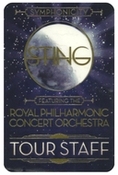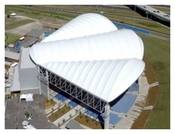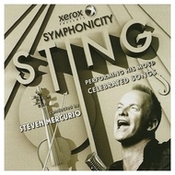
There's Sturm und Drang, the 18th century German arts movement involving the unleashing of extreme emotion. Then there's Sting und Drang, the unleashing of a hot, brainy British dude who doesn't do anything without intensity, self-importance and swagger.
But if you stayed away from the 58-year-old's show at 1-800-ASK-GARY Amphitheatre on Saturday for fear of snoberosity - Sting is travelling with the 45-piece Royal Philharmonic Concert Orchestra, a grandiose move and then some - you don't know the man born Gordon Sumner.
Yes, Sting's been known to whip out his lute at parties. But he's a savvy showman, too. He knows what you crave. He just gives it to you a bit differently.
Reworking 26 solo songs and Police hits, Sting and his mighty orchestra (plus a five-piece rock band on the side) spent more than two hours doling out the bombast for an intimate, pavilion-only crowd of 7,500.
Conducting the oft-thrilling extravaganza was Steven Mercurio, the mad scientist who helped concoct the new, and sometimes drastic, arrangements - and who isn't afraid to shake his classically trained tuchus. You have to dig a maestro who can get down.
Wiggling his own infamous fanny (to the delight of the ladies, okay, and me), Sting opened with 'If I Ever Lose My Faith In You', the pop hit given the slight sheen of a Bond theme. 'Englishman in New York' also retained its original shades, although the strings added a hint of wide-eyed wanderlust. Police smash 'Every Little Thing She Does Is Magic' still cooked, frantic violins playing the part of the love-giddy percussion.
What's the fun in touring with one of the world's greatest orchestras, however, if you don't unleash it in inventive ways. For 'Roxanne', the cut's original prickly heat had calmed into lush, romantic contentment. Once a quiet rumination, 'Russians' was menacing, over-the-top, REALLY LOUD, the stage bathed in red.
(By the way, kudos to the tour's design team. As the orchestra sat on glowing risers, overhead cubes acted as both lights and video screens. Very cool.)
Shifting between playful (punky 'Next To You' was still that, the staid musicians working up a hilarious sweat) and sombre ('Why Should I Cry For You?' about the musician's late father, induced tears with its bittersweet sweep), Sting kept the crowd engaged. He told autobiographical tales (''I was a musician on a cruise ship. [Bleeping] hated it!'') and talked of the curious art of songwriting (he was a huge Bonanza fan growing up - who knew?! - hence the country lilt of 'I Hung My Head').
Sting did robustly faithful versions of 'King of Pain' and 'Every Breath You Take', but the night's highlight was the lesser-known 'Moon Over Bourbon Street', about a bloodthirsty ghoul roaming New Orleans. Seemingly inspired by Hitchcock composer Bernard Hermann, Mercurio guided the orchestra to an eerie froth as Sting, in vampirical cloak, unleashed the creepy, even to the point of working a theremin. It was silly but stirring, the star taking our current goofy love of blood-suckers to clever highs. Sting can be pompous. But he can be pretty darn good, too.
(c) St. Petersburg Times by Sean Daly
Sting takes orchestral direction...
Rock and symphonies rarely make for a good mix. Either the tunes get smothered
in syrupy overkill or the classically-trained musicians are forced to saw away
on three chords.
However, Sting's Saturday night performance with the Royal Philharmonic Concert
Orchestra (''I borrowed them from the queen,'' he quipped.) worked more often
than not for three reasons.
One, Sting's songs, even the simplest sounding ones, are rich enough
harmonically and melodically to given an arranger something with which to work.
Second, Sting was willing to transform, or have his songs transformed, in the
orchestral setting; 'Roxanne' was radically reworked into a torch song that did
away with the chorus altogether.
Third, and most importantly, he resisted the temptation to wield the orchestra
like a weapon. The arrangements were for the most part judicious, economical and
sympathetic. Featuring the clarinet in 'Englishman in New York' cleverly tied
the song to Gershwin's 'Rhapsody in Blue', and the orchestra moved seamlessly
from the song's original rhythm to a jazzy swing for the solo section.
The introduction to 'Russians' was a rare bit of bombast, but the tense and
forceful arrangement added appropriate drama.
Still, the orchestra couldn't salvage the weaker material, and 'Why Should I Cry
For You?' and 'Whenever I Say Your Name' dragged down the set near the
intermission.
In the second set, the orchestra added cinematic sweep to 'Moon Over Bourbon
Street' and 'End of the Game'.
About 7,500 attended the concert at the 1-800-Ask-Gary Amphitheatre.
(c) Tampa Bay Online by Curtis Ross
July 3, 2010
SET LIST
- If I Ever Lose My Faith In You
- Englishman In New York
- Every Little Thing She Does Is Magic
- Roxanne
- Straight To My Heart
- When We Dance
- Russians
- I Hung My Head
- Shape Of My Heart
- Why Should I Cry For You?
- Whenever I Say Your Name
- Fields Of Gold
- Next To You
- A Thousand Years
- Tomorrow We'll See
- Moon Over Bourbon Street
- End Of The Game
- You Will Be My Ain True Love
- All Would Envy
- Mad About You
- King Of Pain
- Every Breath You Take
- Desert Rose
- She's Too Good For Me
- Fragile
- I Was Brought To My Senses




